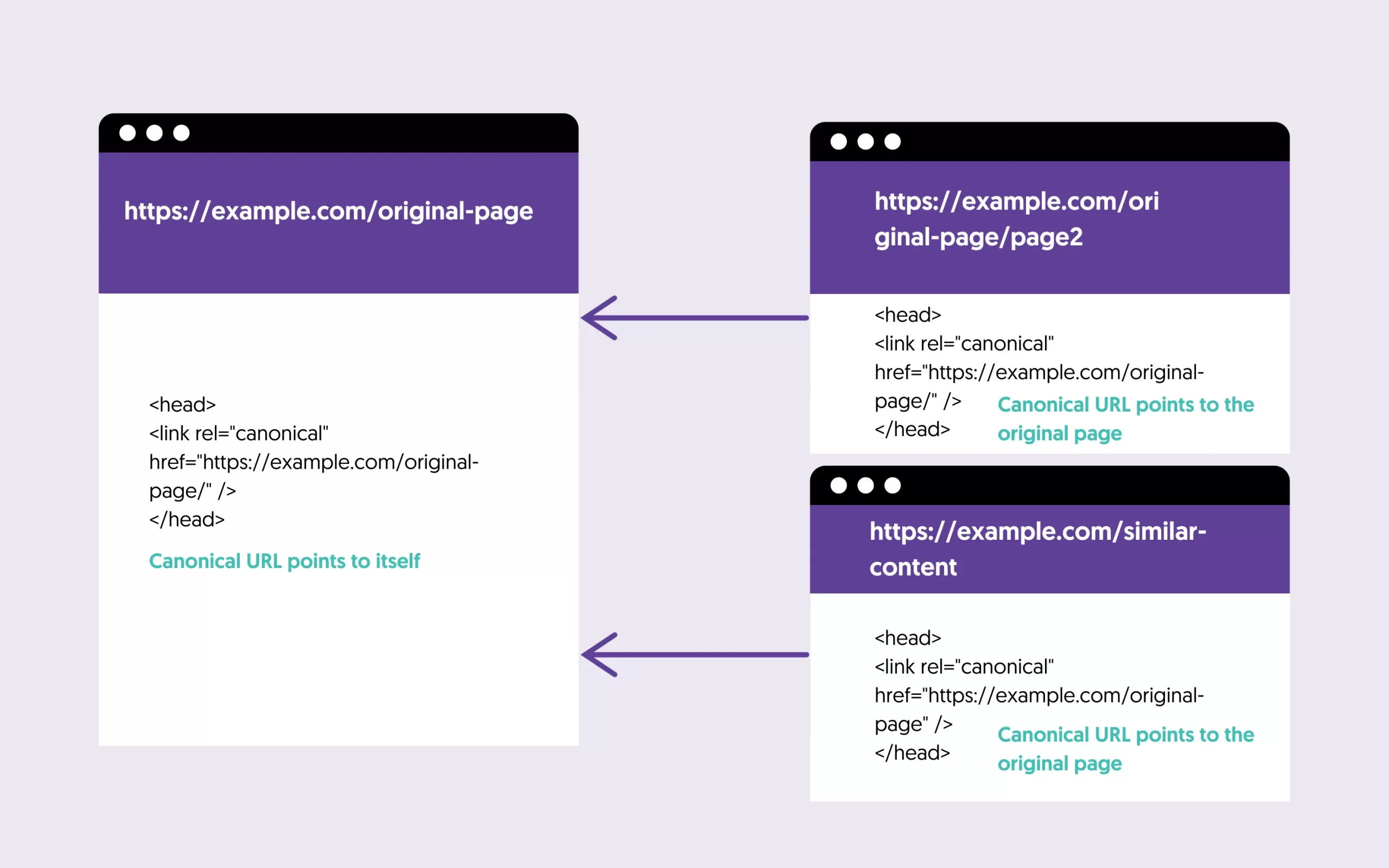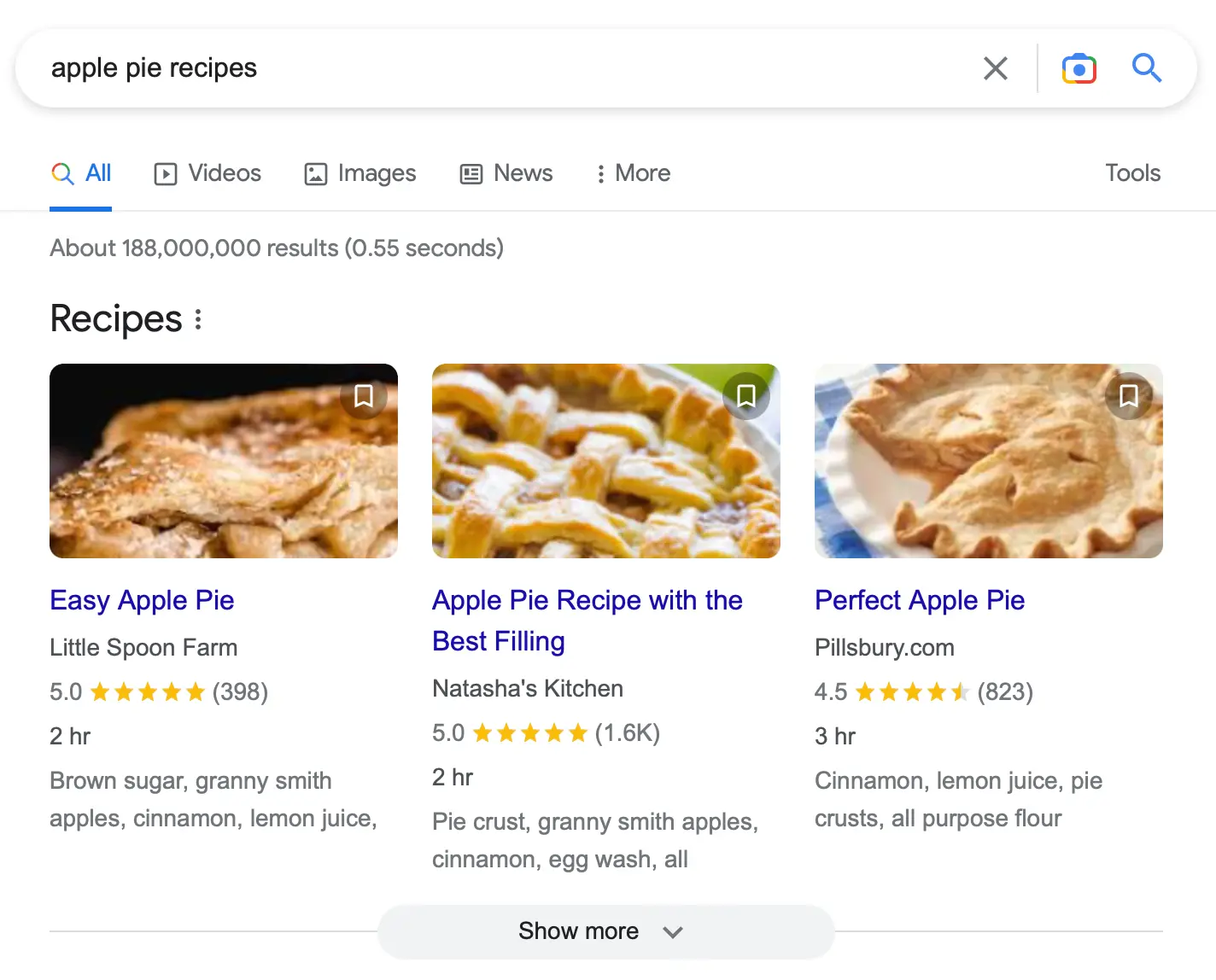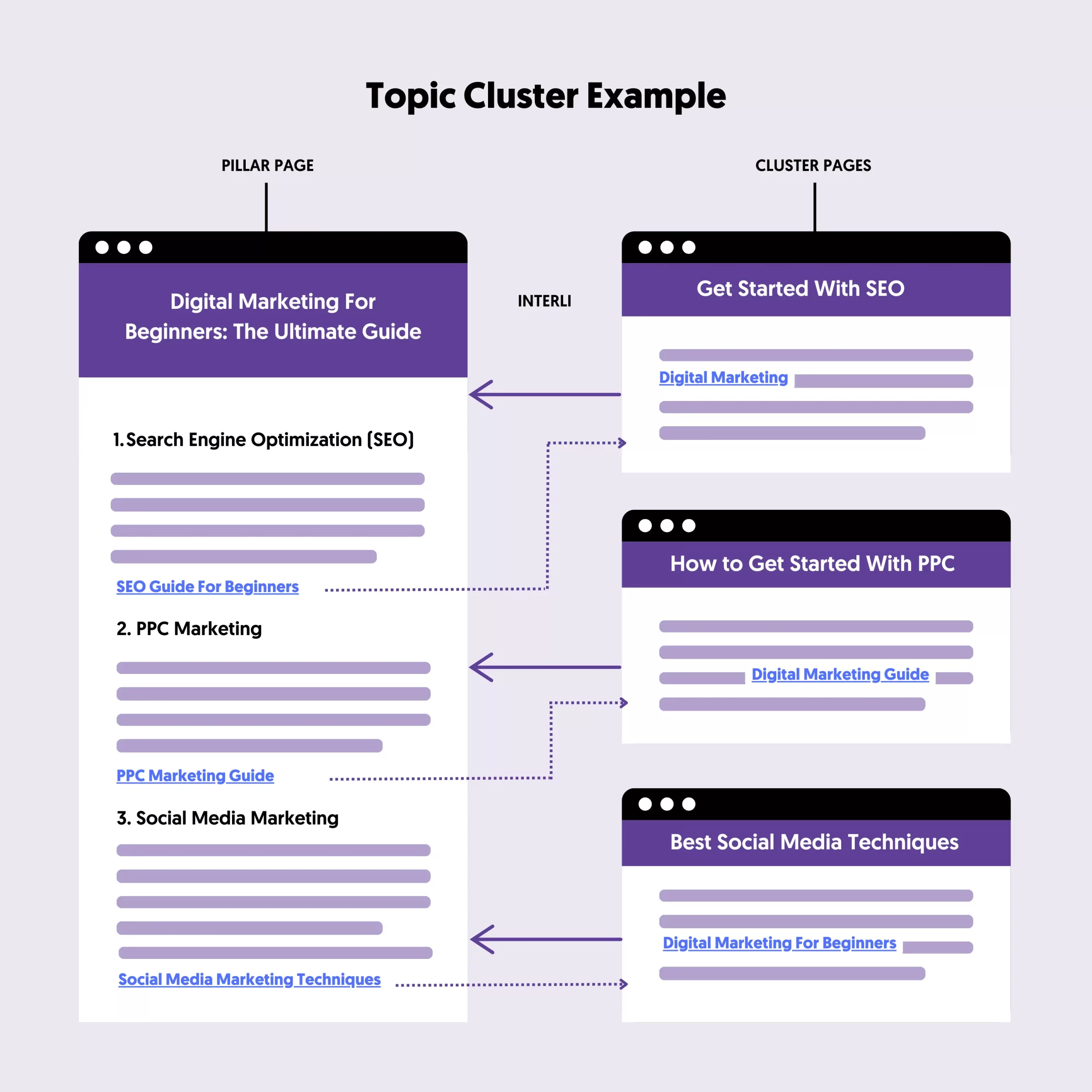In this guide, you’ll learn how to optimize your website step-by-step. By implementing these techniques you’ll improve search engine traffic, create a better user experience, and make your website more profitable.
What is Website Optimization?
Website optimization is the process of improving the traffic, performance, and usability of a website. The ultimate goal of website optimization is to create a website that better serves your users.
In turn, this can lead to improved search engine rankings, higher conversions, more sales, and a more profitable business overall.
10 Website Optimization Techniques
The best optimization strategies to improve your website are:
- Search Intent
- Page Experience
- Technical SEO
- Site Structure
- Link Building
- Structured Data
- Content Marketing
- Brand Awareness
- Content Relevancy
- Conversion Optimization
1. Search Intent
The first optimization strategy is ensuring your content satisfies the search intent. Put simply, the intent is what the user is looking for in a particular keyword or topic.
There are four types of searches that people make:
- Informational: Users are looking for information about a specific topic.
- Navigational: Users are looking for a specific website.
- Commercial: Users are investigating products or services.
- Transactional: Users are looking to purchase a product or service.
An easy way to determine user intent is to see what’s currently ranking for your chosen keyword. Just by skimming the highest-ranking content, you’ll be able to determine what Google believes the intent of the keyword is.
When you’re updating older content or writing a new post, ensure it aligns with what’s currently ranking and satisfies the user’s goals.
In practice, this means:
- Reviewing your Google Search Console reports and finding which search queries your pages showed up in Google but have a low CTR. Using these keywords in your content can improve rankings and generate more traffic.
- Providing a better experience for users. Look at your competitors and find ways to present content in a way that is more useful to the user. Adding custom-made visuals and research data are ways to offer users more helpful content.
Another website optimization technique is to review your existing pages and either update or remove them. Google Helpful Content is a site-wide algorithm that denotes websites that have large amounts of pages that don't offer real value to users.
2. Page Experience
A site optimization strategy that can improve your website is optimizing for the page experience. The Page Experience is a group of factors used by Google during the ranking process.

In particular, it includes the following:
- Core Web Vitals Score - These are KPIs related to how fast your website loads on desktop and mobile. To pass the core web vitals, your website must load in less than 2.5 seconds.
- SSL - Your pages should be served over a secure connection. This means your URLs should start with HTTPS.
- Mobile-Friendliness - The overall experience of users on mobile should be the best possible without having popups or other intrusive interstitials.
- Content Formatting - Content should be easy to read and distinguishable from ads.
Ensure that as part of your website review process, these factors are taken into consideration otherwise, your website's performance in Google will be degraded.
3. Technical SEO
A website's visibility and performance can be affected if there are technical SEO errors. Technical SEO ensures that search engine crawlers can access and index a website's content without problems.
Some basic checks to perform are:
Check indexation
Is your site being indexed by the search engines? Here’s a quick way to check. Head over to Google and type in “site:yoursite.com”.
This will show you what pages and posts are being indexed by Google. Ideally, you’ll see every page and post you’ve published.
Check robots.txt
A robots.txt file controls which pages of your site can be indexed by search engines. Having false statements in your robots.txt file can ruin your organic traffic. Navigate to “yoursite.com/robots.txt”.
If you see the following code:
User-agent: *
Disallow: /
This means your site is blocking all search engines from accessing your content. Spend some time to review robots.txt best practices and ensure that it is properly optimized.
Check URL canonicalization

Your home page should only have a single URL associated with it, for example, “yourdomain.com”. However, you might have multiple different URLs which refer to the same thing, for example:
- yourdomain.com
- https://yourdomain.com
- http://www.yourdomain.com
Usually, Google will choose a version of your site to index, but it could also index multiple versions, leading to confusion and duplicate content.
Review your canonical URLs to avoid duplicate content issues.
Fix broken links
Broken links can create a poor user experience, along with crawling issues.
You can use a tool like Google Search Console to identify broken links and 404 pages across your site. Then, you can update these links, or add a 301 redirect if the page no longer exists.
4. Site Structure
If you built out your website without a long-term site plan, then there’s a chance your site is a jumbled mess of pages. By refining and optimizing your website structure you can improve your search engine rankings, and elevate your user experience across the board.
After all, it doesn’t matter how good your site looks if your users find it impossible to navigate.
Here are a few reasons to improve site structure:
- It improves your search engine appearance when users search for your site or business name
- You make it easier for the search engine bots to crawl and index all of your site pages
- You make it simple and easy for users to navigate your site and find the information they’re looking for, leading to improved on-page SEO metrics
Here’s a process you can follow to improve your site structure:
- Evaluate and remove old content that’s low-quality or no longer relevant
- Combine shorter pieces of content into longer, more valuable posts
- Reevaluate your categories, consider merging and splitting categories based on the total volume of posts
- Improve your internal linking structure and link to your most valuable content, along with older posts
5. Link Building

One of the most important factors in ranking your website is link building. According to Google, it’s one of the top 3 ranking factors.
There are a ton of different strategies you can employ to build quality backlinks:
- Create better content. By creating content better than what’s currently ranking, you can not only steal your competitor’s backlinks but also attract links naturally.
- Build from broken links. You can find sites with broken links and create better content, then reach out to the site owner and see if they’ll link to your improved article.
- Guest blog on authority sites. Find relevant and authoritative blogs in your niche open to guest blogging.
- Analyze your competitor backlinks. Finding and replicating your competitors link building strategies is one of the most effective ways to improve your link profile.
Besides link building, use other off-page SEO techniques to increase your website's trust and credibility.
6. Structured Data
helps Google understand what your page is about and the type of content that’s on the page.
Schema markup on its own won’t help you rank higher in the search engines, but it can help you get more space in the search results, like showing up in the rich snippets.

Adding schema markup to your pages can also help to improve your search engine CTR. For example, if you run a recipe blog, schema markup can show additional useful information, encouraging users to click your result instead of another website.
Here are the most common forms of schema you can add to your site:
- Events
- Local business information
- Recipes
- Star reviews
- Articles
Not every type of schema will apply to your website. But you should be able to find at least one type of schema that works.
Adding schema to your website is easy. If you’re running a WordPress website, all you need to do is install a plugin and choose your schema type.
7. Content Marketing
Using topic clusters and pillar pages is a technique to improve your website's content.
With topic clusters, you essentially cover everything there is to know about a topic. A topic cluster includes pillar pages and cluster pages interlinked together to help you build authority about a topic.
Topic ClustersThese can help your site in two ways:
- It organizes your content and makes your site easier to navigate
- It can give you a boost in the search engines
Pillar pages help to show Google what your content is about. Your pillar page will help to unite different categories of content.
Here are some guidelines to follow when creating pillar pages:
- Analyze your existing content to look for topic clusters (i.e., related content that falls under a larger category)
- See if this content can be combined into a larger post with chapters or links to existing articles
- Research high-traffic keywords that you’ll be able to target with your pillar pages
- Create the absolute best online resource on your chosen topic/keywords
8. Brand Awareness
Google favors authority websites. These sites have good content and high-quality backlinks, offering an incredible user experience. All of these fall under the umbrella of web optimization.
It’ll be difficult for you to build a strong personal brand or business without getting all of these factors right.
Becoming an authority in your niche doesn’t have to be that difficult, either.
- Test your messaging and overall branding to better align with your audience.
- Create high-quality, relevant content that your audience loves and shares
- Network with influencers in your space for backlinks and improve brand association
- Optimize your website for speed and performance to improve user experience
These are just a few methods this post covers to help you build an authoritative online business.
9. Content Relevancy
Producing more content takes time, energy, and even money. But you can improve your rankings by updating your old content without writing more posts.
In time, your content becomes less relevant, and by updating it, you improve your freshness score and can see a jump in traffic.
Here’s a handful of reasons/methods for updating your old content:
- Updating the article date can improve search engine CTR
- Make your content more accurate and better than what’s currently ranking
- Fix any old typos and make the content more readable
- Update any broken links and link to better resources
- Add new media, illustrations, and graphics to improve time-on-site metrics
- Optimize for new keywords or better optimize your content as a whole
10. Conversion Optimization
When looking at your website traffic, email subscribers, and revenue, you want these numbers to increase continuously.
But the answer isn’t always more traffic and more buyers. Often, the better approach is improving the conversions you’ve already got.
Put simply, conversion optimization is the process of increasing the number of website visitors that turn into customers or take a specific action.
Here are a few ways you can improve your site’s conversions:
- A/B testing. You change a portion of your website and run traffic to the two versions, then study the data to see what converts the best.
- Your value proposition. This spells out the unique value that your website offers your visitors. The clearer this is, the better.
- Your website copy. A lot of copy is too wordy and colloquial. Use simple and clear language when describing what you sell or do.
- Your CTAs. Experiment with different call-to-action copy, placement, and colors.
Conversion optimization saves you from buying more ads or writing more content. Instead, you optimize what you’ve got and generate more profit from your current traffic and customers.
Web Page Optimization Tools
There are a handful of website optimization tools you can use to execute the website optimization strategy outlined above. Here are the 5 tools worth checking out:
SEMRush
SEMRush is a full-fledged digital marketing suite. You can use Semrush to conduct an SEO audit. The report will give you a breakdown of any technical SEO issues and what you can do to fix them. You can also use Semrush to uncover what keywords your competitors are ranking for and find your competitor's backlinks.
Google Search Console
Google Search Console is a collection of tools offered by Google that helps to paint a picture of the performance of your website in Google. It’ll give you useful information like if your site is infected with malware, what keywords you’re ranking for, the backlinks pointing towards your site, and more.
Google Analytics
Google Analytics is a free tool that gives you in-depth analytics on your website traffic. Once you’ve synced up your website with Google Analytics, you’ll start to get in-depth data about your site.
Google Pagespeed Insights
Google Pagespeed Insights will analyze your website speed on mobile and desktop and give you ways to improve it. All you have to do is run your website through the tool, and you’ll get a score of 100. The higher the number, the better optimized your website is.
Yoast SEO
If you’re running a WordPress site, you need the Yoast SEO plugin. With Yoast, you can fix duplicate content issues and canonical URLs, create a sitemap, and other sitewide SEO optimizations.
Website Optimization Benefits
Here are some of the biggest benefits of optimizing your website:
Get more search engine traffic - One of the main reasons to go through the SEO optimization process is to improve site visibility in Google and other search engines and get more traffic to your website.
For example, as you create high-quality, relevant content, you’ll attract backlinks or create linkable assets you can use to build links. This will grow your authority and help you rank higher in the search engines.
Improving on-page user-experience metrics will also show Google your site is high-quality and relevant, which can boost rankings as well.
Overall, the better your site meets the needs of your users and the better the user experience you provide, the higher your website will rank.
Save on advertising costs - Another big advantage is that you’ll have to pay less for advertising. When your website is ranking organically and optimized to convert at a higher rate, you can scale back on paid ads.
With PPC advertising, you pay every time someone clicks on an ad and visit your site. When you stop paying, this traffic source completely dries up. But, with organic traffic, you aren’t paying anything for traffic. You’ve invested in achieving these rankings, but once you’ve proven to Google that your site or pages hold value, it can be a long-term passive traffic source.
Convert more visitors into leads/sales - Most websites are full of holes. Instead of new visitors becoming subscribers and customers, they leave your site, never to return.
One big part of site optimization is plugging all of these holes. Anyone can build a website, but most people won’t build a website that converts.
By optimizing your website, you give your audience exactly what they want. This leads to more sign-ups and higher conversions (whatever your conversion goals).
By becoming the go-to resource for your customers, you’ll not only improve brand loyalty, but you’ll be able to earn more income on the traffic you’re already getting.
Key Learnings
Website optimization can help you unlock more revenue from your existing traffic and help your site grow positively (more traffic and more customers).
Without spending time optimizing your website, you’re doing your business a disservice. Ultimately, the goal of your website is to serve your customers in the most effective manner possible.
If you’re looking for quick wins, start by fixing any technical SEO issues, update and improve your old and outdated content, and create a more streamlined site structure.
In time, you can start improving your overall authority by creating pillar content, refining existing content to align with user intent, and building relevant backlinks to your content.
Site optimization isn’t a one-and-done process but something that becomes part of the natural evolution of your site. Your site will grow, just as your business does, but with real-time data gained from A/B testing, you can ensure your site is constantly pushing the needle towards a better user experience.




